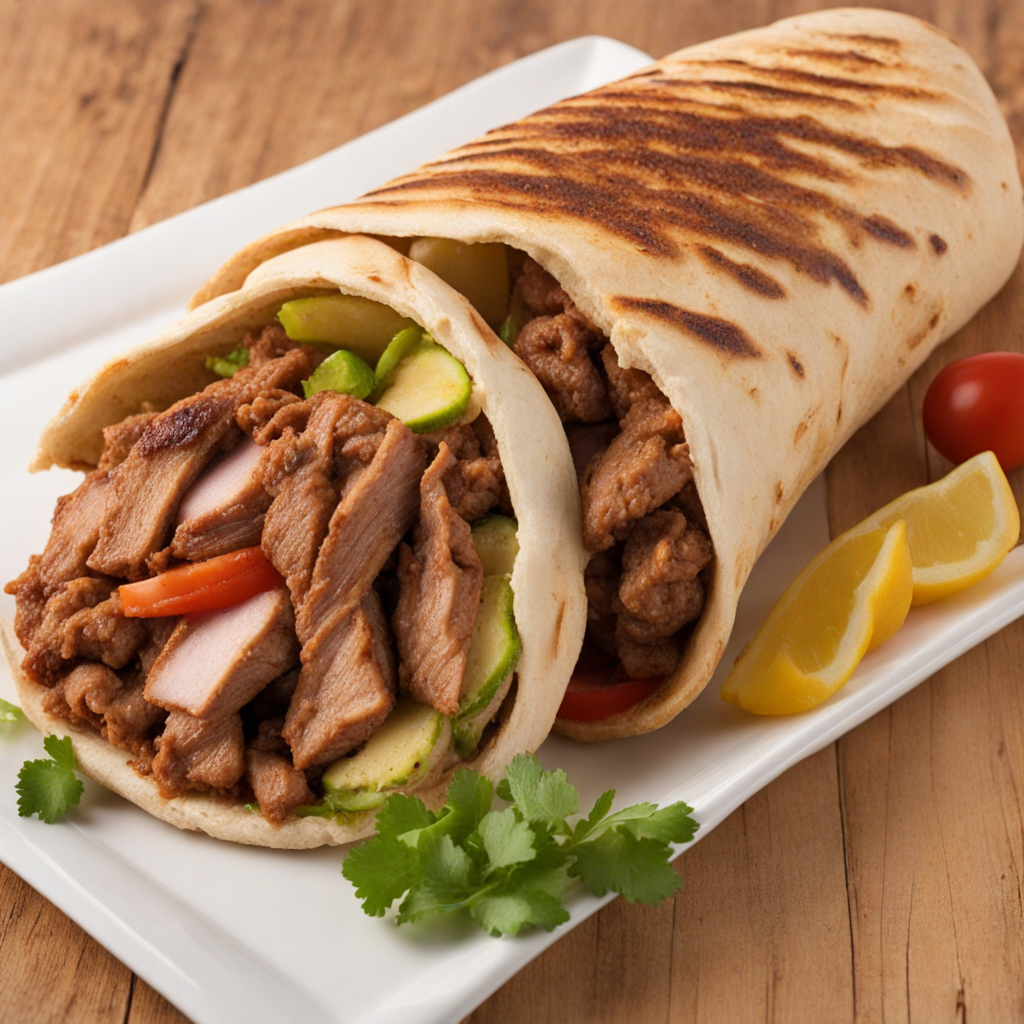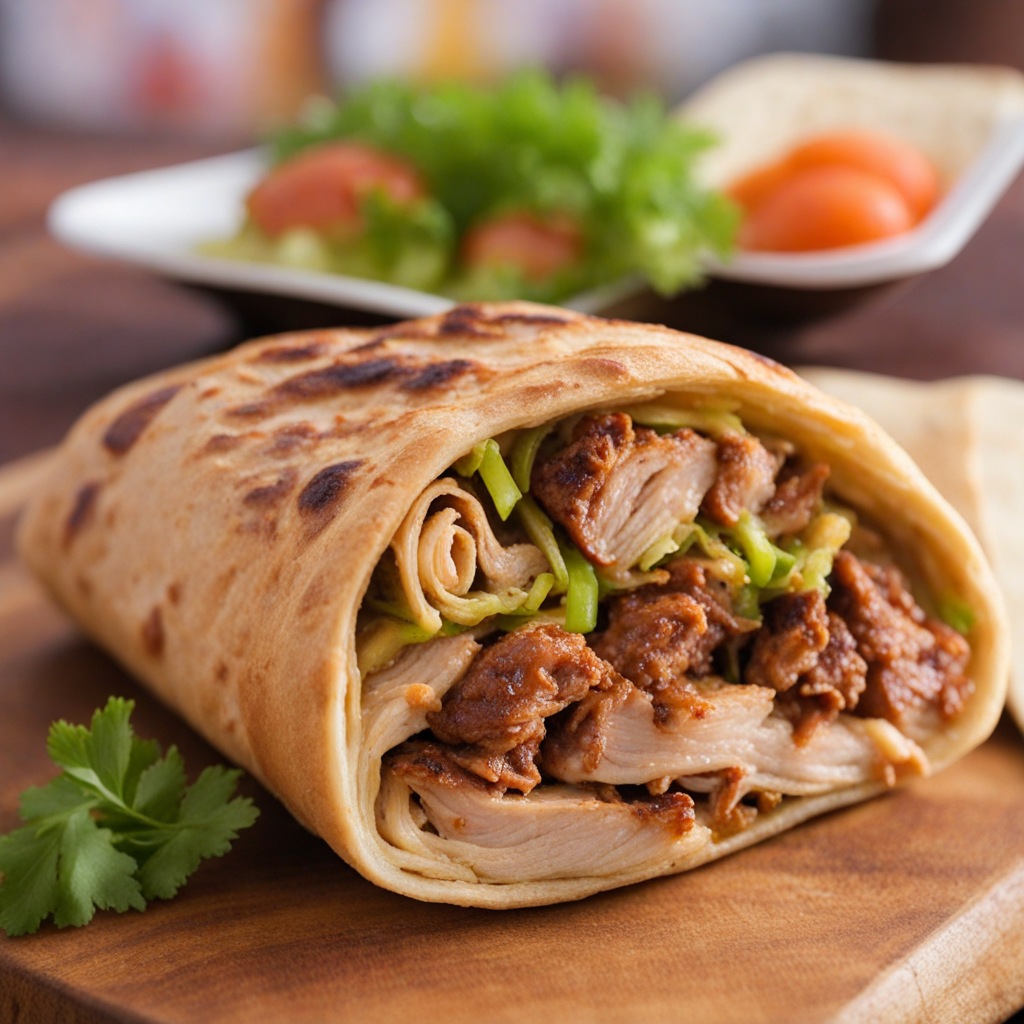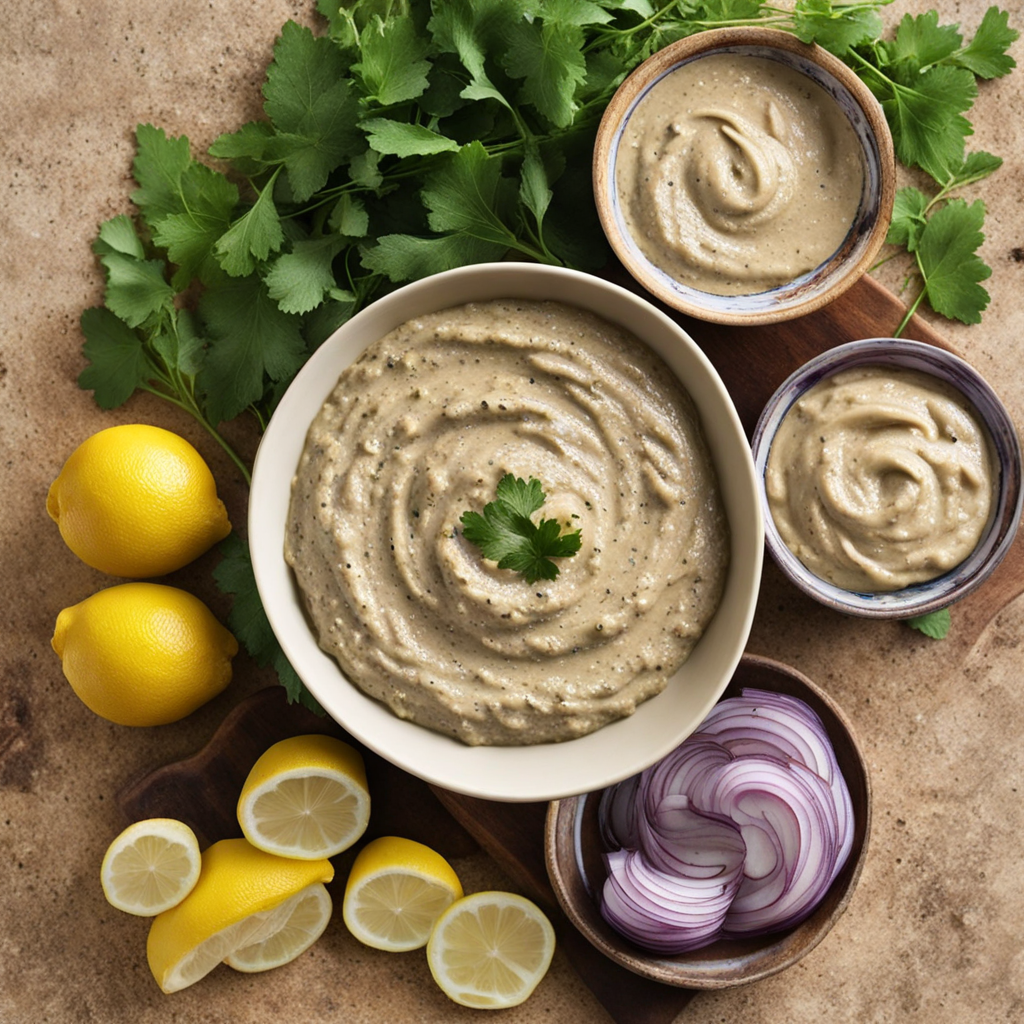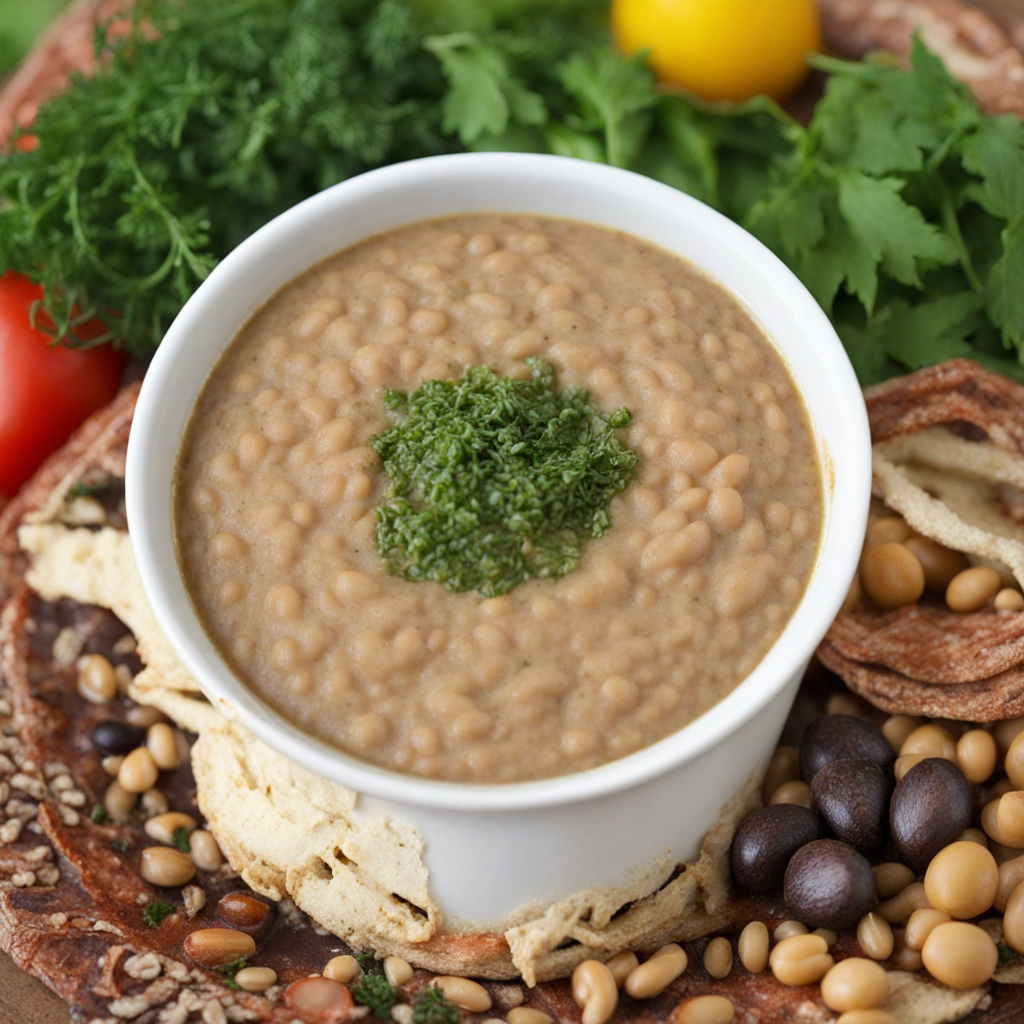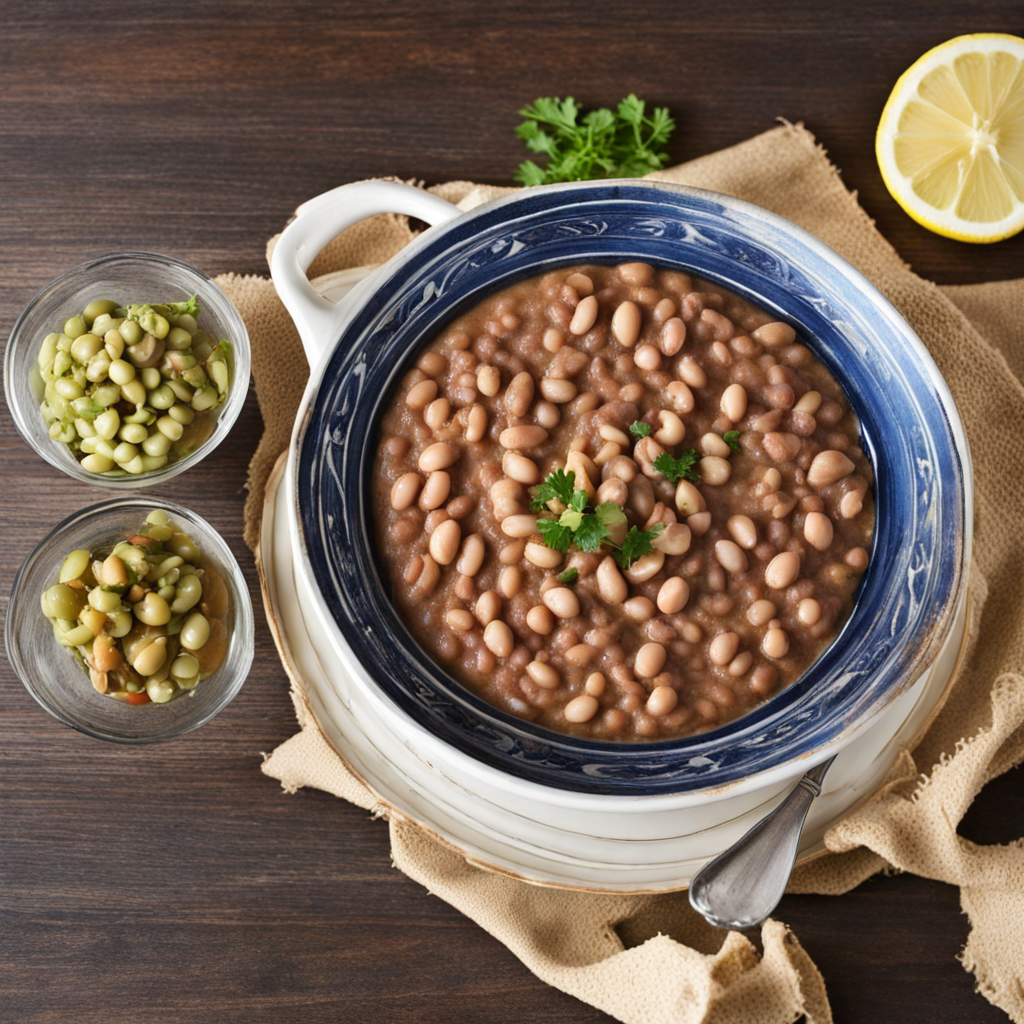Shawarma
Shawarma is a popular street food that originates from the Middle East, and in Egypt, it has evolved into a beloved culinary staple. This dish typically features marinated meat, which can be beef, chicken, or lamb, that is seasoned with a rich blend of spices such as cumin, paprika, and garlic. The meat is stacked in a cone-like shape on a vertical rotisserie, which slowly cooks it to perfection. As it turns, the outer layer becomes beautifully browned and crispy, while the inside remains tender and juicy. This unique cooking method enhances the flavors and creates a delightful textural contrast that is simply irresistible. Once cooked, the Shawarma is thinly sliced and often served in a warm pita or flatbread, accompanied by a variety of fresh toppings. Common accompaniments include crunchy pickles, fresh vegetables like tomatoes and cucumbers, and tangy sauces such as tahini or garlic sauce. Each bite is a harmonious blend of flavors and textures – the savory meat, the freshness of the vegetables, and the creamy richness of the sauces come together to create a satisfying experience for the palate. The use of spices not only adds depth but also brings a warmth that lingers pleasantly after each bite. In Egypt, Shawarma is often enjoyed as a quick meal on the go, making it a favorite among locals and visitors alike. It can be found at street vendors and specialized restaurants, each with its own twist on the classic recipe. Whether you choose to indulge in a traditional version or a modern take with unique toppings, Shawarma promises an explosion of flavor that introduces you to the vibrant culinary culture of Egypt. Its combination of aromatic spices, succulent meat, and fresh ingredients makes Shawarma a must-try for anyone eager to explore new tastes.
How It Became This Dish
The History of Shawarma: Egypt’s Flavorful Journey #### Origins of Shawarma Shawarma, a dish that has become synonymous with Middle Eastern cuisine, boasts a rich history that dates back to the Ottoman Empire, which thrived from the late 13th century until the early 20th century. The term "shawarma" itself is derived from the Turkish word "çevirme," meaning "to turn," which aptly describes the method of cooking the meat on a vertical rotisserie. This cooking technique likely originated from the Turkish döner kebab, which features seasoned meat cooked on a rotating spit. Although shawarma is often associated with various Middle Eastern cultures, Egypt holds a unique place in its narrative. The Egyptians adapted the concept of the rotating spit to create their version of shawarma, which became popular in the bustling streets of Cairo. The dish features marinated meats, typically lamb, chicken, or beef, that are stacked on a vertical spit and slowly roasted. As the outer layer cooks, it is shaved off and served, often wrapped in pita bread or alongside rice and vegetables. #### Cultural Significance Shawarma is more than just a popular street food; it is a cultural phenomenon that reflects the social fabric of Egyptian society. The dish is widely enjoyed across different demographics, making it a staple in both casual and formal gatherings. In Egypt, shawarma stands can be found in busy markets, along streets filled with pedestrians, and even in upscale restaurants, showcasing its versatility and appeal. Food has always played a significant role in Egyptian culture, serving as a means of connection among families and communities. Shawarma, with its flavorful spices and savory aromas, has become a symbol of hospitality and sharing. It is often served during social gatherings, celebrations, and even as a late-night snack after a lively evening, embodying the spirit of togetherness. Moreover, shawarma has been influenced by the diverse culinary traditions of Egypt’s history. The country has seen waves of conquests, trade, and cultural exchanges that have shaped its cuisine. Egyptian shawarma often incorporates local spices and ingredients, giving it a unique twist that sets it apart from its counterparts in other regions. #### Development Over Time The evolution of shawarma in Egypt can be traced through the 20th century as globalization began to influence culinary practices. The post-World War II era saw a rise in urbanization, with cities like Cairo becoming melting pots of different cultures. As Egyptians traveled abroad and expatriates returned home, they brought back culinary inspirations that enriched the local food scene, including shawarma. During this period, shawarma gained immense popularity among the younger generation, who embraced the dish for its convenience and flavor. Street vendors began to proliferate, each adding their own twist to the recipe and presentation. Some vendors experimented with different meats, marinades, and toppings, leading to the emergence of diverse shawarma styles. Egyptian shawarma often features toppings like tahini sauce, garlic paste, and pickles, which enhance the flavor profile and add layers of texture. The 1980s and 1990s marked a significant turning point for shawarma in Egypt as it began to be recognized internationally. Egyptian restaurants opened in various parts of the world, showcasing traditional dishes, including shawarma. This exposure not only popularized the dish globally but also allowed for cross-cultural exchanges that further diversified its preparation and ingredients. In the 21st century, shawarma has seen a resurgence in popularity, particularly among millennials and health-conscious consumers. Many shawarma vendors have adapted their menus to include healthier options, such as whole wheat pita, grilled vegetables, and lean meats. Furthermore, the rise of food delivery services has made it easier than ever for people to enjoy shawarma from the comfort of their homes. #### Shawarma in Modern Egypt Today, shawarma continues to be a beloved dish in Egypt, embodying both tradition and innovation. With a myriad of vendors offering various styles, the shawarma landscape has become increasingly competitive. The emergence of gourmet shawarma restaurants has introduced new flavors and presentations that appeal to a wide audience, showcasing the dish's adaptability. Culinary festivals and food fairs in Egypt frequently feature shawarma, celebrating its cultural significance and bringing together chefs from different backgrounds to share their interpretations of the dish. These events highlight the versatility of shawarma, as vendors experiment with fusion flavors, incorporating ingredients from other cuisines while maintaining the essence of the original dish. Moreover, shawarma has also found its way into the global food scene, gaining recognition as a popular fast-casual option. Food trucks and restaurants specializing in shawarma have popped up in cities worldwide, appealing to diverse palates and introducing the dish to new audiences. This globalization has allowed shawarma to transcend its origins and become a beloved food item across various cultures. #### Conclusion In conclusion, shawarma is a dish steeped in history and cultural significance, particularly in Egypt. From its origins in the Ottoman Empire to its evolution as a cherished street food, shawarma reflects the diverse culinary influences that have shaped Egyptian cuisine. As it continues to adapt to modern tastes and trends, shawarma remains a symbol of hospitality, community, and the rich tapestry of flavors that define Egypt's food culture. Whether enjoyed in a bustling Cairo market or a trendy restaurant, shawarma’s journey through time is a testament to its enduring appeal and the connections it fosters among people.
You may like
Discover local flavors from Egypt


